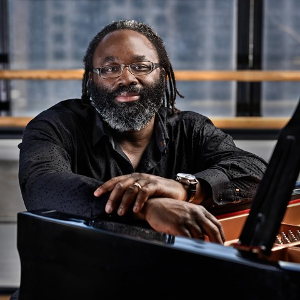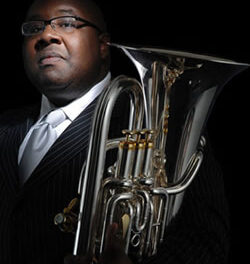The Eastern Music Festival concluded its 56th season with a spectacular concert in Dana Auditorium on the campus of Guilford College in Greensboro. It had to be spectacular because the bar had been set exceedingly high from the outset of the season. (Just how high is reflected in CVNC‘s coverage of a total of fifteen of its offerings this summer; see them all by searching the arts journal, online.)
The grand finale, performed by the Eastern Festival Orchestra, the symphonic ensemble consisting of EMF artist faculty members and 2017 orchestral fellows under the direction of Music Director Gerard Schwarz, filled the stage and the hall with radiant sound. The program consisted of standard fare – the prelude to Act I of Wagner’s Die Meistersinger, Grieg’s Piano Concerto, with the distinguished American pianist Awadagin Pratt as soloist, and Shostakovich’s Symphony No. 5 in D minor, Op. 47 (1937). To tell the truth, this is the kind of line-up that might have made a cynic claim the marketing department had preempted the programming prerogatives of the artistic staff. That old critical canard hardly applies here, however, because this is a teaching festival, the manifold musical benefits of which routinely, nay consistently include, alongside bracing accounts (and amounts) of new music, shedding new light on familiar scores, some of which are almost certainly being experienced for the very first time by the students who come from all over to immerse themselves in the art more than a few of them will likely pursue in some form for the rest of their lives.
Thus the brilliant overture seemed to take on new life as realized by these professional artist/teachers and the orchestra’s stage-filling augmentees, with Schwarz knowingly shaping the overall course of the music. The concert ending of this curtain-raiser was of course inevitable in this setting, but surely more than a few of us would have preferred to have the music go on and on, so stirring was the playing.
The Grieg, too, is old hat, but as heard on this occasion, the concerto was infused with new life. At the risk of repeating the obvious, it is clear that the seating used by Schwarz for the strings – violins divided, left and right, with violas behind the second violins and cellos and basses arrayed alongside and behind the firsts (as exemplified by Arturo Toscanini and many of his contemporaries) – made a huge difference in clarity and audibility as experienced from the hall. And such strings! On one or two occasions there seemed to be too few cellos, or perhaps there was a bit too much from the others, but for the most part the sound gripped its hearers with vibrant immediacy, further enhanced by the players’ incisiveness and intensity. Soloist Pratt seemed in his element – this artist is in his prime in terms of technique and artistry, and one could almost feel all the lacquer being brushed away from the keyboard part. He and Schwarz worked together as one well-oiled machine (but with heart and soul always at the forefront), producing one of the best-balanced and integrated renditions this listener has yet heard. And ah! The color and shading the ensemble brought to the music, beyond the superior strings: these players include many of our nation’s best woodwind, brass, and percussion artists, and they were all in top form for the concerto.
The second half featured the work with which Shostakovich restored himself – for a time – to favor with Stalin. It’s variously described, as detailed in the EMF’s excellent program book; but since the end of the war (WWII that is), it has taken on a still larger life of its own, playing a major role in important cultural exchanges between the former Soviet Union and the West. (Bernstein’s NYP performances and recording captured the attention of non-classical people throughout America, much as Van Cliburn’s big Russian victory did, but in retrospect the key to understanding Shostakovich’s orchestral works must rest in the recordings left by the Leningrad Philharmonic, many of which are readily available on YouTube. For still more information, click here.)
Schwarz & Co. did themselves proud, bringing out the score’s alternating serenity, bombast, cynicism (that word again!), and bluster. (Who marches to music like that nowadays aside from the North Koreans?) Thanks to the conductor’s keen ears and discrete but firm cues to the players, the clarity of the performance resulted in the ability of the audience to hear everything that really matters in the music. At the end there was a tremendous ovation for Schwarz, the players, and indeed the score as well, for it is a magnificent thing, this symphony. When it was written, the Russians were on the verge of becoming our allies and friends, and not for the last time. We’re in a particularly bad patch with them now, but if there’s to be hope for our planet, going forward, this scribe remains confident that the arts will play a role in helping secure peace and tranquility. As EMF closes out this summer, here’s a big thank you for a stunning reminder of what really matters in all this.
When the Moiseyev Folk Ballet appeared for a full hour on the old Ed Sullivan Show in 1958, the gregarious host observed that if we could sidestep politicians, the people of the world would manage to get along just fine, united by art. It’s been nearly 60 years since then. Maybe we should try again.












